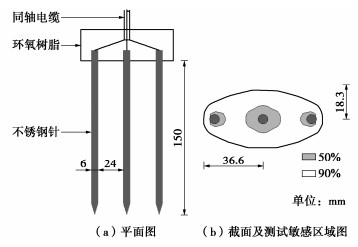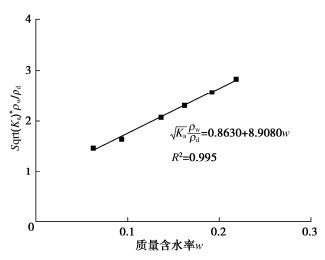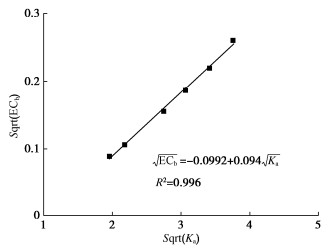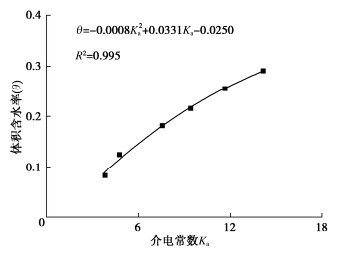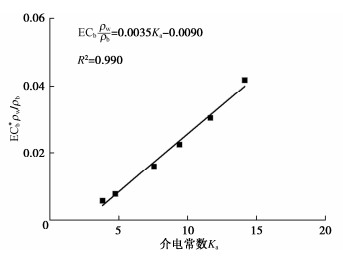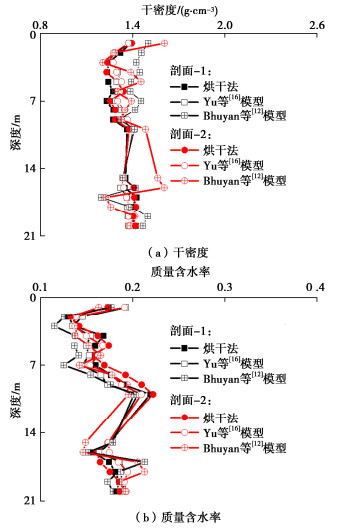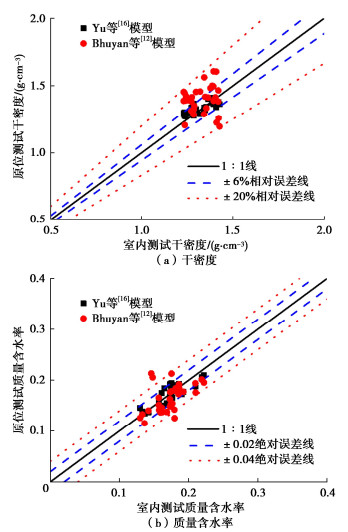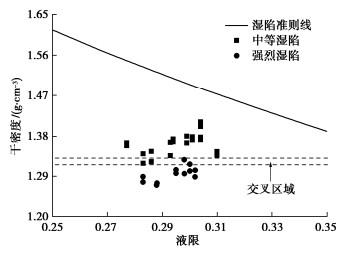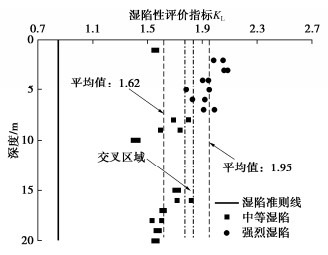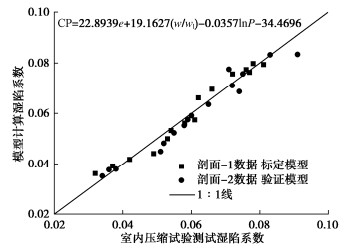In-situ evaluation of collapsible loess through time-domain reflectometry
-
摘要: 现有黄土湿陷评价方法具有取样扰动、耗时和费用高等缺点,急需探索原位评价黄土湿陷的新技术。基于时域反射技术(TDR)原位测试黄土介电常数和电导率,计算干密度和质量含水率。依据原位所测黄土干密度、质量含水率以及物性指标(相对质量密度、液塑限),采用经验模型对黄土进行湿陷评价。结果表明,TDR原位测试黄土干密度和室内烘干法结果相对误差在±6%以内,测试黄土质量含水率和室内烘干法结果绝对误差在±0.02以内。另一方面,基于经验的湿陷评价模型,利用TDR原位所测干密度、质量含水率以及物性指标不仅可判定黄土有无湿陷,且具有区分强烈和中等湿陷程度的潜力。本研究丰富了黄土地区勘察技术手段,为黄土湿陷原位勘察提供有益探索。
-
关键词:
- 时域反射技术(TDR) /
- 黄土 /
- 湿陷 /
- 原位评价
Abstract: It is urgent to propose a new technique for the in-situ evaluation of collapsible loess, as the existing methods are time- and cost-consuming, and may lead to inevitable sampling disturbance. The gravimetric water content and dry density of loess are computed by the dielectric permittivity and electrical conductivity measured by the time-domain reflectometry (TDR) in the field. The collapsibility of loess is evaluated using the computed gravimetric water content, dry density of loess and physical properties of soil (i.e., specific gravity, plastic and liquid limits) through empirical relationships. Comparing with those obtained by the oven-dried method, the dry density and gravimetric water content of loess by the TDR are within a relative error of ±6% and an absolute error of ±0.02, respectively. On the other hand, empirical relationships relating the gravimetric water content, dry density and soil physical properties to the collapsibility show a good performance to evaluate collapsible loess. Moreover, the strong and medium collapsible loess may also be characterized. This study extends the techniques of site investigation in loess regions and provides beneficial explorations for the in-situ evaluation of collapsible loess.-
Keywords:
- time-domain reflectometry /
- loess /
- collapsibility /
- in-situ evaluation
-
-
表 1 基于室内压缩试验的不同深度黄土湿陷程度判定
Table 1 Grades of collapsibility of loess at different depths based on laboratory compression tests
深度/m 湿陷系数 湿陷程度 剖面-1,σ 剖面-2,σ 剖面-1 剖面-2 200
/kPa上覆土饱和自重 200
/kPa上覆土饱和自重 1.0 0.058 0.059 中等 中等 2.0 0.081 0.083 强烈 强烈 3.0 0.090 0.091 强烈 强烈 4.0 0.072 0.071 强烈 强烈 5.0 0.076 0.074 强烈 强烈 6.0 0.077 0.072 强烈 强烈 7.0 0.078 0.075 强烈 强烈 8.0 0.066 0.065 中等 中等 9.0 0.062 0.060 中等 中等 10.0 0.053 0.052 中等 中等 15.0 0.054 0.058 中等 中等 16.0 0.061 0.055 中等 中等 17.0 0.049 0.051 中等 中等 18.0 0.042 0.038 中等 中等 19.0 0.037 0.036 中等 中等 20.0 0.032 0.034 中等 中等 注:①湿陷系数依据GB/T50123—2019[3];②湿陷程度依据GB 50025—2018[19];③σ为试验压力。 -
[1] 陈正汉. 非饱和土与特殊土力学的基本理论研究[J]. 岩土工程学报, 2014, 36(2): 201–272. doi: 10.11779/CJGE201402001 CHEN Zheng-han. On basic theories of unsaturated soils and special soils[J]. Chinese Journal of Geotechnical Engineering, 2014, 36(2): 201–272. (in Chinese) doi: 10.11779/CJGE201402001
[2] MU Q Y, ZHOU C, NG C W W. Compression and wetting induced volumetric behavior of loess: macro and micro-investigations[J]. Transportation Geotechnics, 2020, 23: 100345. doi: 10.1016/j.trgeo.2020.100345
[3] 土工试验方法标准: GB/T 50123—2019[S]. 2019. Standard for Geotechnical Testing Method: GB/T 50123—2019[S]. 2019. (in Chinese)
[4] 陈存礼, 褚峰, 李雷雷, 等. 侧限压缩条件下非饱和原状黄土的土水特征[J]. 岩石力学与工程学报, 2011, 30(3): 610-615. https://www.cnki.com.cn/Article/CJFDTOTAL-YSLX201103022.htm CHEN Cun-li, CHU Feng, LI Lei-lei, et al. Soil-water characteristics of unsaturated undisturbed loess under confined compression condition[J]. Chinese Journal of Rock Mechanics and Engineering, 2011, 30(3): 610–615. (in Chinese) https://www.cnki.com.cn/Article/CJFDTOTAL-YSLX201103022.htm
[5] 穆青翼, 党影杰, 董琪, 等. 原状和压实黄土持水特性及湿陷性对比试验研究[J]. 岩土工程学报, 2019, 41(8): 1496–1504. https://www.cnki.com.cn/Article/CJFDTOTAL-YTGC201908017.htm MU Qing-yi, DANG Ying-jie, DONG Qi, et al. Water-retention characteristics and collapsibity behaviors: comparison between intact and compacted loesses[J]. Chinese Journal of Geotechnical Engineering, 2019, 41(8): 1496–1504. (in Chinese) https://www.cnki.com.cn/Article/CJFDTOTAL-YTGC201908017.htm
[6] 邵生俊, 杨春鸣, 马秀婷, 等. 黄土的独立物性指标及其与湿陷性参数的相关性分析[J]. 岩土力学, 2013, 34(增刊2): 27–34. https://www.cnki.com.cn/Article/CJFDTOTAL-YTLX2013S2005.htm SHAO Sheng-jun, YANG Chun-ming, MA Xiu-ting, et al. Correlation analysis of collapsible parameters and independent physical indices of loess[J]. Rock and Soil Mechanics, 2013, 34(S2): 27–34. (in Chinese) https://www.cnki.com.cn/Article/CJFDTOTAL-YTLX2013S2005.htm
[7] HOLTZ W G, HILLF J W. Settlement of soil foundations due to saturation[C]//Proceedings of the 5th International Conference on Soil Mechanics and Foundation Engineering. 1961. Paris.
[8] GIBBS H J, BARA J P. Predicting surface subsidence from basic soil tests[J]. Special Technical Publication, ASTM, 1962, 322: 231–247.
[9] 叶为民, 崔玉军, 黄雨, 等. 黄土的湿陷性及其评价准则[J]. 岩石力学与工程学报, 2006, 25(3): 550–556. doi: 10.3321/j.issn:1000-6915.2006.03.018 YE Wei-min, CUI Yun-jun, HUANG Yu, et al. Collapsibility of loess and its discrimination criteria[J]. Chinese Journal of Rock Mechanics and Engineering, 2006, 25(3): 550–556. (in Chinese) doi: 10.3321/j.issn:1000-6915.2006.03.018
[10] BASMA A A, TUNCER E R. Evaluation and control of collapsible soils[J]. Journal of Geotechnical Engineering, 1992, 118(10): 1491–1504. doi: 10.1061/(ASCE)0733-9410(1992)118:10(1491)
[11] TOPP G C, DAVIS J L, ANNAN A P. Electromagnetic determination of soil water content: measurements in coaxial transmission lines[J]. Water Resources Research, 1980, 16(3): 574–582. doi: 10.1029/WR016i003p00574
[12] BHUYAN H, SCHEUERMANN A, BODIN D, et al. Soil moisture and density monitoring methodology using TDR measurements[J]. International Journal of Pavement Engineering, 2020, 21(10): 1263–1274. doi: 10.1080/10298436.2018.1537491
[13] MU Q Y, ZHAN L T, LIN C P, et al. Non-invasive time domain reflectometry probe for transient measurement of water retention curves in structured soils[J]. Engineering Geology, 2020, 264: 105335. doi: 10.1016/j.enggeo.2019.105335
[14] ROTH K, SCHULIN R, FLÜHLER H, et al. Calibration of time domain reflectometry for water content measurement using a composite dielectric approach[J]. Water Resources Research, 1990, 26(10): 2267–2273.
[15] SIDDIQUI S I, DRNEVICH V P, DESCHAMPS R J. Time domain reflectometry development for use in geotechnical engineering[J]. Geotechnical Testing Journal, 2000, 23(1): 9–20. doi: 10.1520/GTJ11119J
[16] YU X, DRNEVICH V P. Soil water content and dry density by time domain reflectometry[J]. Journal of Geotechnical and Geoenvironmental Engineering, 2004, 130(9): 922–934. doi: 10.1061/(ASCE)1090-0241(2004)130:9(922)
[17] 赵云, 凌道盛, 王云龙, 等. 改进一步法模型及TDR自适应方法研究[J]. 岩土工程学报, 2016, 38(5): 818–827. doi: 10.11779/CJGE201605007 ZHAO Yun, LING Dao-sheng, WANG Yun-long, et al. Modified one-step method and its adaptive system of TDR[J]. Chinese Journal of Geotechnical Engineering, 2016, 38(5): 818–827. (in Chinese) doi: 10.11779/CJGE201605007
[18] CURIONI G, CHAPMAN D N, ROYAL A C D, et al. Time domain reflectometry (TDR) potential for soil condition monitoring of geotechnical assets[J]. Canadian Geotechnical Journal, 2019, 56(7): 942–955. doi: 10.1139/cgj-2017-0618
[19] 湿陷性黄土地区建筑标准: GB50025—2018[S]. 2018. Standard for Building Construction in Collapsible Loess Regions: GB50025—2018[S]. 2018. (in Chinese)
[20] 土的工程分类标准: GB/T50145—2007[S]. 2017. Standard for Engineering Classification of Soil: GB/T50145—2007[S]. 2017. (in Chinese)
[21] JUNG S, DRNEVICH V P, ABOU NAJM M R. Temperature corrections for time domain reflectometry parameters[J]. Journal of Geotechnical and Geoenvironmental Engineering, 2013, 139(5): 671–683. doi: 10.1061/(ASCE)GT.1943-5606.0000794
[22] ROTHE A, WEIS W, KREUTZER K, et al. Changes in soil structure caused by the installation of time domain reflectometry probes and their influence on the measurement of soil moisture[J]. Water Resources Research, 1997, 33(7): 1585–1593. doi: 10.1029/97WR00677
[23] 詹良通, 穆青翼, 陈云敏. 三针式TDR探头测试区域范围分析及试验验证[J]. 岩土工程学报, 2014, 36(4): 757–762. doi: 10.11779/CJGE201404022 ZHAN Liang-tong, MU Qing-yi, CHEN Yun-min. Analysis and experimental verification of sampling area of three-rod time-domain reflectometry probe[J]. Chinese Journal of Geotechnical Engineering, 2014, 36(4): 757–762. (in Chinese) doi: 10.11779/CJGE201404022
[24] LI P, LI T L, VANAPALLI S K. Influence of environmental factors on the wetting front depth: a case study in the Loess Plateau[J]. Engineering Geology, 2016, 214: 1–10. doi: 10.1016/j.enggeo.2016.09.008
[25] FEDA J. Structural stability of subsident loess soil from Praha-Dejvice[J]. Engineering Geology, 1966, 1(3): 201–219. doi: 10.1016/0013-7952(66)90032-9



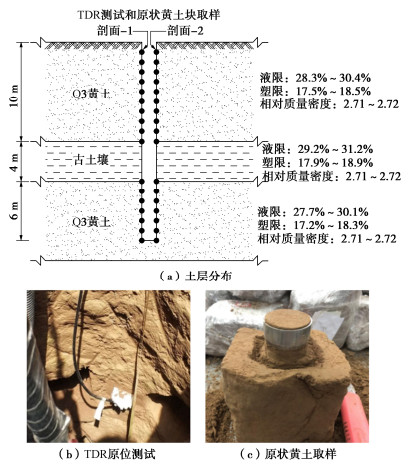
 下载:
下载:
